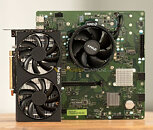These have got to be a DIY dev kit for the game devs
I cant see much else of a purpose for them
As mentioned above, these are harvested dice. You can't build a console dev kit from a harvested defective die.
Actually it was
Gen 2 X4, like the article mentions. Honestly I wonder what was the point with the 4700S now, the only real advantage is the smaller form factor, but the old PCIe interface and lack of M2 slots always felt like artificially imposed limits. Maybe AMD has negotiated a better deal with Sony (or Microsoft?) that allows them to make these defective APUs more palatable?
I think they just lacked the general purpose PCIe lanes on that chip to make it feasible. Sony has its own storage controller after all, and both the m.2 slot and on-board flash reportedly go through that. That controller likely has a PCIe interface of some sort, but it might not be capable of anything but storage, and might not even natively support NVMe storage - depends how they configured the interface on the die. To me the 4700S seemed like a clear case of an "eh, well, I guess we can try to make this useful despite its massive limitations" scenario. It's a bit of a shame, as that CPU with at least
some decent I/O would have been pretty good (at the right price).
Bundling an RX 6600 with it may be the only way they can sell these. The previous version cost too much for what was a one-off, dead-end platform with hobbled features, no flexibility and no future.
At $400, the 4700S was the same price as a full-fat 3700X (~$300), a half-decent B450 board ($70) and 8GB kit ($30) Why the hell would anyone buy a slower CPU that also can't really support a dGPU properly, on a board that sucks with zero upgrade prospects instead for the same money?
Worse than that, the 4700S is nowhere near a fair comparison for the 3700X. Whilst it shares the same 8C/16T configuration, it has only a quarter of the L3 cache and runs at lower clocks. In tests (THG took a look at one of the kits) it was a good 30% slower, not even outpacing the far older 2700X and the $200 R5 3600 would handily beat it even in multi-threaded workloads despite two fewer cores.
So, it's a turd on paper and the real-world performance makes the on-paper spec look good.
You're not entirely wrong, but you can't discount the effect of slow GDDR on CPU performance either. CPUs need latency more than bandwidth, so GDDR for a CPU is just begging for a performance loss. IMO that's as much of the fault for the poor CPU performance as the smaller caches - remember, the mobile/desktop APUs have similarly small caches and perform well still.
This, given that it has some useful I/O, might actually be useful, but they really need to sell these dirt cheap. Making use of rejected silicon is a good thing, but the pricing needs to reflect its capabilities. Still, these could make for some really nice internet cafe rigs in China, for example - small, decent performance, low power, easily put together, and hopefully cheap. Outside of that these don't make all that much sense though.
I was talking about one below pci-e slot.
That looks like a PCIe x1 slot to me.












